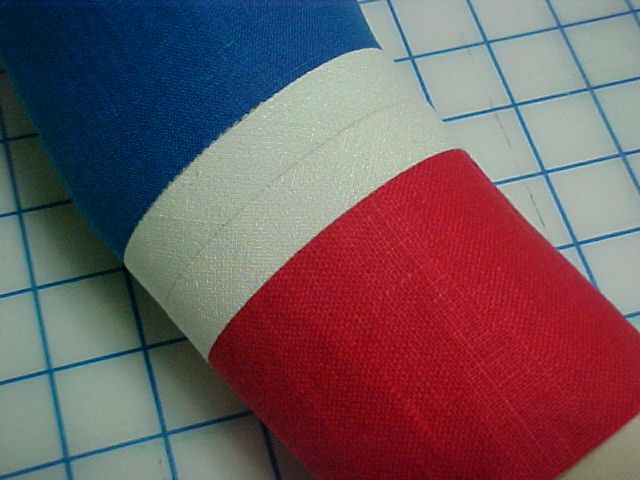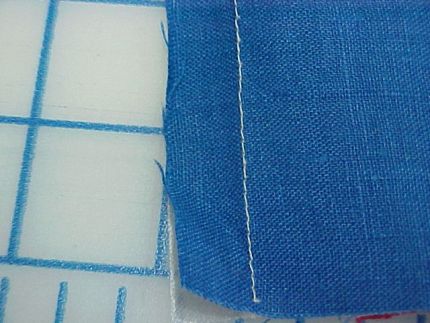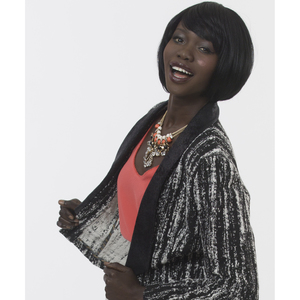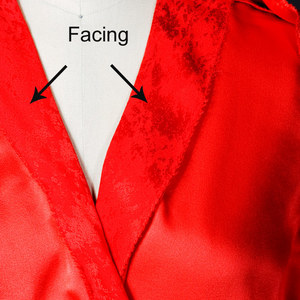
This technique came from a vintage suit I saw a few months ago. The idea was used to extend the sleeves with bias fabric inserts. The suit was in a very small glen plaid and the inserts on the bias added interest. I thought it would also be a great way to extend a pant hem or add interest to a straight skirt. This technique could be used to lengthen different areas in a garment but also to add interest using contrasting colors as it is shown here.
In the example shown, the blue fabric is the sleeve. The two white bias strips are the inserts. The two bias strips when sewn together and pressed around the raw edges of the red and blue fabric finish at 5/8-inches wide each. The white bias fabric is cut 4 times the finished width. Example: 4 x .625 (5/8-inches) = 2.5-inches wide. You will need a 2.5-inch wide bias strip for every insert sewn in the garment. This width accommodates both the bias strip for the blue fabric and the second strip for the red fabric, which is the sleeve extension. The remaining amount provides for wrapping the seam allowances around the raw edges known as the ‘turn of the cloth’. The red fabric (the sleeve extension or cuff) is cut twice the finished width desired plus 2 additional seams allowances (an additional 1 1/4″) for the example used. The bias inserts and the extension can be any width when finished, but the bias should start at 4 times that measurement and the extension can also be any width when finish, but must start out twice the finished width plus two seam allowances.
Sew one bias strip to the adjoining blue fabric with a 5/8-inch wide seam allowance.
Sew the other white bias strip to the red fabric with a 5/8-inch wide…
Start your 14-day FREE trial to access this story.
Start your FREE trial today and get instant access to this article plus access to all Threads Insider content.
Start Your Free TrialAlready an Insider? Log in



































This is a good idea in theory but not in practice. I keep my clothes for a long time and in my experience bias tape disintegrates long before linen or other natural fabrics.
You are not using bias tape, but fabric cut on the bias. The illustration in the technique has three different colors of linen to show the steps. The technique could be sewn in all the same colored fabrics...think strips, a small plaid or a linen weave...the bias insert would show off all your work.
Sincerely, Louise Cutting
This is a great idea for using up scraps of fabric that's already cut on the bias. Cuffs don't take up much fabric. This would add an interesting touch to a collar too.
You know, I never thought of this. It would certainly make a nice embellishment. But, given the slightly "stretchy" nature of fabric cut on the bias, I'm wondering if it might also be useful in areas like the elbow of a close fitting sleeve where a little extra movement would be helpful. Hmmm... possibilities!
Absolutely a genius idea from a genius sewer! Louise Cutting has the most fabulous, useful and brilliant sewing techniques.
I must try this sometime, and of course this opens up all kinds of possibilities!!
I would think you would not want to put this strip at the elbow or any other stress point. Seems to me that a bias strip at the elbow is going to get very baggy after a while and you'll end up with a permanently stretched spot. You could prevent this by underlining the sleeve in one piece, I think.
LOVE this! Think of adding a bias band with embroidery or a several bias bands with tiny lace peeping out. This I will have to use. Excellent!
It is unfortunate that your example did not use a fabric which would better illustrate your idea. A small plaid would have shown it well. It does indeed look like bias tape in your example. Not really a great idea.
I think this is a unique idea. I think the criticism that it would stretch is not relevant because you have two straight grain pices essentially stitched together. The criticism that bias tape woudln't be good, make your own. Especailly if you are using a plaid, you would have to. I do agree that the images are a bit confusing, but if you read the directions along with it, Loise gives a very complete picture. Thank you for sharing this.
Love this idea! And wouldn't it be cute to embroidery a small motif on a bias strip and use faggoting to connect it? I got about 12 ideas that ran through my head when I read this article. I love Louise Cutting, she is full of really great ideas and techniques. Keep them coming!
Louise, thankyou for once again providing a brilliant solution to a common problem.
I don't understand the posters who think that bias will stretch if it is already stitched to a straight-grain edge, but they will learn in time to trust you.
I am thinking this would also be a way to effectively lengthen sleeves on a purchased garment. By using the bias to join the edges of the garment fabric and the lining fabric, and pressing the bias to the inside, like a false cuff.
Please continue to share your genius with us!!
Jean Morgan
Thank you for the lesson today: Embellishments, Carla's Opera Coat
I've printed out page 4: Gusset and snaps, page 7: Replicate of closure, page 6: Hair canvas and its interesting roll lines.
I will experiment with that gusset sleeve on the bias. I appreciate quality and excellent designs.
I once found a terrific princess cut linen suit at a consignment store here in California. It was a salmon, short sleeved jacket and straight skirt. It was one size too small so I used the, too short, skirt material to enlarge with a gusset at the side. (My friend Ione Holzman did the work, she use to work for Edith Head.) I've had it ten years and it goes with all my fall colors, brown or tan skirts and printed blouses. An unbottoned jacket makes you look slimmer, yet professional, with its straight lines and sharp tailored collar. I curve in the sides of my other jackets, if they are not princess cuts, which has a slimming effect. (Chanel's ideas!) Sincerely, Virginia
While I have not used bias insets, I have long used double bias binding as my signature way of detailing the bottom edges of skirts, flounces, jackets and sleeves.
I have also used the double bias binding to make extra length in skirts and sleeves.
Thank you, Louise. Your presentation here also lends to a marvelous detailing opportunity I certainly will like to try in future.